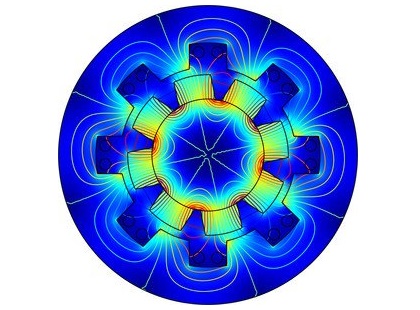عملکرد جدید عمومی در رابط های الکتروشیمی
|
•
|
اگر نام متغیر وابسته phis تغییر کرده باشد، مشکل ویژگی مرزی توان الکترود برای مرحله مطالعه راهاندازی توزیع فعلی برطرف شد. همچنین نام فیلد ضریب لاگرانژ برای درج تگ فیزیک تغییر یافته است. این تغییر نام ممکن است هنگام اجرای Java API مشکلات سازگاری با عقب را ایجاد کند. |
|
•
|
وضعیت جفت پیوستگی در توزیع جریان اولیه/ثانویه، باتری لیتیوم یونی، و باتری با رابط های الکترولیت باینری بهبود یافته است. |
|
•
|
تنظیمات شارژ به گره جدید Species Properties برای توزیع جریان سوم، رابط Nernst–Planck منتقل شده است. |
|
•
|
فعالیتهای غیر ایدهآل اکنون در توزیع جریان سوم، رابط Nernst–Planck پشتیبانی میشوند. همچنین برای محاسبه فعالیتهای غیر ایدهآل با استفاده از معادله Debye-Hückel، بر اساس قدرت یونی محلول، کارکرد اضافه شده است. |
|
•
|
برای همه رابط های الکتروشیمی، گزینه جدید 0.25 ولت (Seawater Ag/AgCl در مقابل SHE) به بخش Physics v. Materials Reference Electrode Potential در گره رابط فیزیک اضافه شده است. |
|
•
|
ورودی های Electrolyte>LiPF6 در 1:1 EC:DMC (باتری مایع، لیتیوم یونی) و Electrode>NMC 532, LiNi0.5Mn0.3Co0.2O2 (مثبت، باتری لیتیوم یونی) را به کتابخانه مواد باتری اضافه کرد. |
|
•
|
گره دامنه جدید رسانه خاص> لایه های باتری در رابط های انتقال حرارت. |
|
•
|
متغیرهای جدید پس پردازش (سطح و میانگین غلظت ذرات وزن شده روی مواد متخلخل) در رابطهای لیتیوم-یون و باتری با الکترولیت باینری اضافه شد. |
|
•
|
تغییر مدیریت متغیر ظرفیت سلول باتری در رابط باتری یکپارچه. با فرمول جدید، ظرفیت موجود برای دوچرخه سواری با کاهش ظرفیت باتری کاهش می یابد. |
|
•
|
مرحله مطالعه برآورد پارامتر و حلکنندههای بهینهسازی BOBYQA، Levenberg-Marquardt و IPOPT اکنون با مجوز ماژول طراحی باتری در دسترس هستند. |
|
•
|
اگر نام متغیر وابسته phis تغییر کرده باشد، مشکل گره مرزی چرخه شارژ-تخلیه هنگام استفاده از مرحله مطالعه راهاندازی توزیع فعلی برطرف شد. این اصلاح در نسخه 6.0 به روز رسانی 2 نیز گنجانده شده است. |
فرمول های شیمیایی پیشرفته در رابط شیمی
فرآیند افزودن گونههای شیمیایی جدید، چه هنگام ایجاد دستی ویژگیهای
گونهها و چه زمانی که از ویژگیهای Reaction گرفته شدهاند، به طور قابل توجهی بهبود یافته و گسترش یافته است.
|
•
|
بخش Name یک گره گونه اکنون شامل نام گونه و نام متغیر مورد استفاده برای پس پردازش است. این نامها برای گونههای باردار، گونههای دارای پرانتز و گونههایی با نشاندهنده فاز متفاوت است. |
|
•
|
گره گونه ها اکنون شامل یک بخش فرمول شیمیایی است که در آن ترکیب گونه ها را می توان بر حسب عناصر جدول تناوبی تعریف کرد (با انتخاب کادر فعال کردن فرمول ). جرم مولی و بار گونه به طور خودکار از فرمول محاسبه می شود. |
|
•
|
بخش Chemical Formula از واحدهای تکراری با استفاده از سه نوع علامت محصور پشتیبانی می کند: ()، []، و {}. یک مثال از این [Al(OH)(OH2)5]^2+ است. |
|
•
|
بخش فرمول شیمیایی از نمایش های بار زیر پشتیبانی می کند: ++، (++)، ^(++)، ^++، ^2+، (2+)، و ^(2+). |
|
•
|
For intricate molecular structures, a simplified (trivial) name can now be used, while the composition and charge are detailed using the Chemical Formula input. When a Chemical Formula is defined, it is used in place of the simplified name when balancing a reaction formula. |
|
•
|
The reaction formula parser used in the Reaction node has been extended to also support species names with repeating units and the extended set of charge representations. |
|
•
|
The error messages shown for invalid species names have been improved. |
IMPROVEMENTS TO THERMODYNAMICS
|
•
|
Constant properties defined by the Thermodynamics functionality can now be evaluated as parameters. |
|
•
|
Evaluation of thermodynamic properties is now faster. Models where a significant part of the solution time is spent evaluating functions from the Thermodynamics functionality can now be solved in 30% less time. |
The filter search field, used when adding species to a thermodynamic system, has been improved. Filtered species can now be entered one at a time, from the top, using the Enter key. Also, it is no longer necessary to update the filter each time a species is added to the
Selected species list.
GENERAL NEW FUNCTIONALITY IN THE CHEMICAL TRANSPORT INTERFACES
|
•
|
The charge and molar mass settings have been moved to the new Species Properties node for the Transport of Concentrated Species interface. Java API back comp is provided for the charge setting commands, but not for the molar mass setting commands. |
|
•
|
The charge settings have been moved to the new Species Properties node for the Nernst–Planck Equations and Transport of Diluted Species interfaces. |
|
•
|
Nonideal activities are now supported in the Nernst–Planck Equations and Transport of Diluted Species interfaces. Functionality has also been added for computing the nonideal activities using the Debye–Hückel equation, based on the ionic strength of the solution. |
|
•
|
Consistent stabilization is now available when using the Maxwell–Stefan diffusion model in the Transport of Concentrated Species interface. |
|
•
|
The Maxwell–Stefan diffusion model can be combined with turbulent flow when using the Reacting Flow multiphysics interfaces. |
|
•
|
The Periodic Condition for mass transport can now be combined with wall conditions for fluid flow when using the Reacting Flow or Reacting Flow, Diluted Species coupling feature. In the case of turbulent flow, the wall concentration is made periodic by applying the constraint to the wall function. |
|
•
|
شرایط فن داخلی اکنون توسط ویژگیهای جفتکننده جریان واکنشدهنده و جریان واکنشدهنده، گونههای رقیقشده پشتیبانی میشوند. |
|
•
|
یک ویژگی جدید شکستگی ، سازگار با سایر ویژگیها برای انتقال رسانه متخلخل، اکنون در دسترس است. این ویژگی شامل دو گره فرعی، Fluid و Fracture Material ، شامل تنظیمات برای فازهای مربوطه است. |




